
The owner of Akre trees, who has family connections with the Ralia Estate (see here), not only claims to have advised Abrdn on their purchase of “Far Ralia” but to be behind the native woodland project for the estate (see here). Akre also appears lined up to carry out the planting should Scottish Forestry give the go-ahead. So what is their track record?
Akre Trees has carried out a number of other tree planting projects to date so in May I went to have a look at what they had done at Leckie (see here), a “traditional Scottish Estate” on the northern slopes of the Gargunnock Hills not far from Stirling. This, like Far Ralia , is presented on their website as being an important project to sequester carbon and restore natural ecoystems:
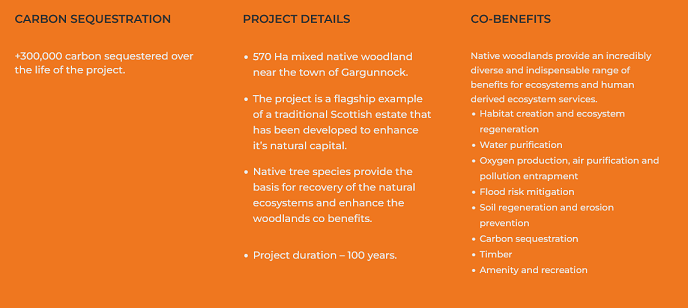
Another family connection
What is not stated on the Akre website is that this is another estate where there is a connection between Renwick Drysdale of Akre/Kilrie Trees and the Findlay family:
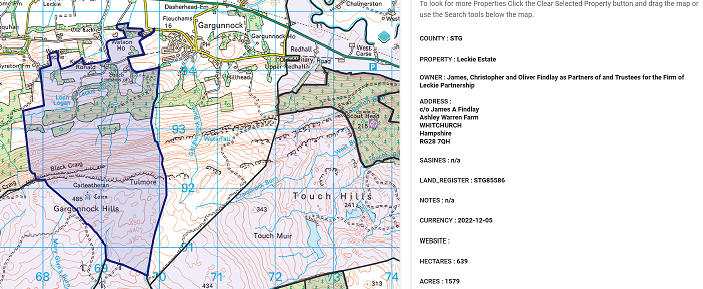
Without going into all the details, it appears that James Findlay is the brother of Alasdair Findlay, the laird at Ralia, and is the person who, ten years ago, was described as the joint owner of the Drumochter and Ralia estate (see here).
There is nothing unlawful about Akre/Kilrie Trees doing business with estates with family connections. But those connections in my view add to the argument that both Abrdn and the public authorities involved in consider their proposals at Far Ralia should take a close look at what has happened at Leckie before taking any decisions.
The tree planting at Leckie
Even from a distance (top photo) it is apparent that a large proportion of the native woodland planting at Leckie is in straight lines, uses mounding and that the trees are planted very close together.

As you approach the plantation it becomes apparent that significant areas of woody vegetation have been chopped and cleared to plant the trees and the main technique used has been hinge mounding, whereby an excavator is used to turn over surface vegetation and the soil below leaving a hole beside it. The trees which have then been planted on top of the mounds have been protected with guards which appear to be plastic.

Accessing the site
I had approached the plantation from above, as I wanted to get a good view down over it, and found that it was entirely surrounded by a deer fence reinforced with wire mesh on the bottom half designed to keep out rabbits but also obstructing access.

Akre reported one of the “co-benefits” of this scheme as “amenity and recreation”. While there was a gate on the eastern boundary (see above), I traversed c2 kilometres along the slopes above the fence on the upper side of the plantation and only saw one gate. Without sufficient access points there can be little or no amenity or recreation. Thankfully, most of the proposals to use deer fencing at Far Ralia, as I will show in my next post, have been removed from the plans now being considered by Scottish Forestry.
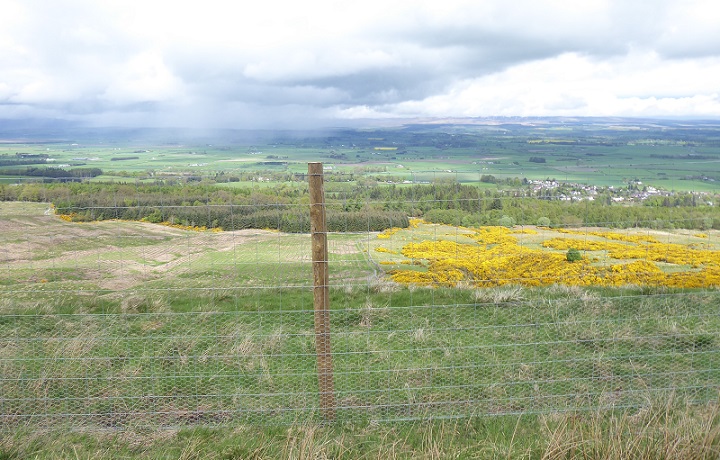
How Scottish Forestry, which has a contract with the Leckie Partnership and appears to have funded the scheme, agreed to this fence from an access perspective is unclear.
The fence, however, is a symptom of a broader issue, as illustrated in the photo above: plantations have a significant impact on the landscape and natural environment while often creating straight lines through natural landforms. Those considerations are very relevant to what is proposed at Far Ralia, should we really be modifying large areas of land in this way in National Parks?
From an aspect perspective, the trees at Leckie are planted so close together that, even if there was no fence, in ten years time it may be more difficult to wander through the new “woodland” than the large gorse areas on the right. Moreover, because of the hinge mounding, watch out for those holes!
The impact of the planting
Inside the plantation evidence showed how large areas of gorse had been “grubbed” up and that little or anything has been allowed to get in the way of planting trees.
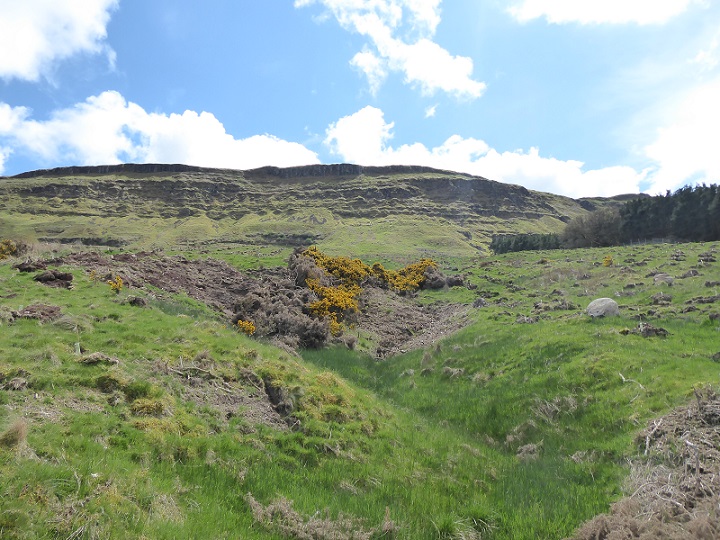
Removal of the gorse has released carbon into the atmosphere and destroyed an important habitat for wildlife as is explained in the latest version (2021) of Natural England’s Carbon Sequestration by Habitat (see here):
“Chapter 3: Open habitats and farmland – Open habitats such heathlands and semi-natural grasslands sequester and store more carbon than modern agricultural landscapes but typically store less carbon than peatlands, saltmarsh and established woodlands. They also sequester less carbon than woodlands, as they do not accumulate woody matter. Vegetation may also be managed by grazing or cutting, representing a loss of carbon from the system”
And,
“Protect existing semi-natural habitats. Most of England has been intensively managed for a long time and semi-natural habitats, of all types, are rare fragments containing many of our native species that are not found elsewhere. Many of these, including grasslands and heathlands, also store appreciable amounts of carbon in their vegetation, undisturbed soils and sediments.”
Unfortunately, NatureScot (see here), the agency responsible in Scotland, appears to have devoted less attention than Natural England to this issue. The question should be answering is how long will it take for the newly planted trees to sequester the carbon that was released into the atmosphere through by the planting?
The James Hutton Institute and Stirling University have, however, researched this question (see here) and found that tree planting on podzolic soils results in a net carbon loss thirty years later:

The more the disturbance caused by the planting, the more carbon is released. While mounding is less destructive of carbon that digging ditches to drain the soil, we still do not know how long if at all it might take for there to a net carbon gain in native woodland such as this. Moreover, the risks of trying to store carbon above ground are considerably greater than storing it below in soils, not least because of fires and windthrowing storms both of which are increasing in frequency in Scotland.

Added to this we should ask how long will it take to offset the fossil carbon used in the planting operations (the machinery and the fuel) and what appear to be plastic tree tubes?
From a nature perspective, a large proportion of the trees that have been planted appear to be species like birch and rowan, easy to grow and ten a penny in Scotland. On the upper ground will they be any better than the gorse, which provides a habitat for birds like yellowhammer which are becoming increasingly rare, or the unimproved grassland they have replaced?
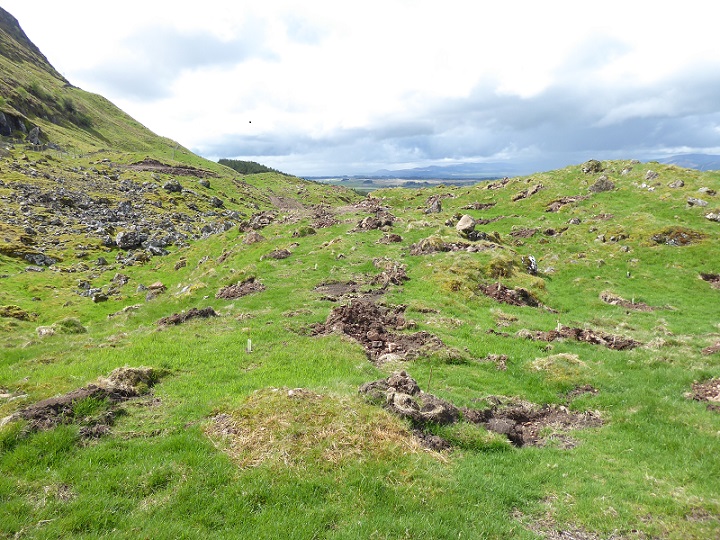
Generally, my working presumption is that if it looks bad from a landscape perspective, it probably is from a carbon and nature perspective. In biodiversity terms will the consequences of this planting or that on the lower marshy ground (below) be any better than what is has replaced?
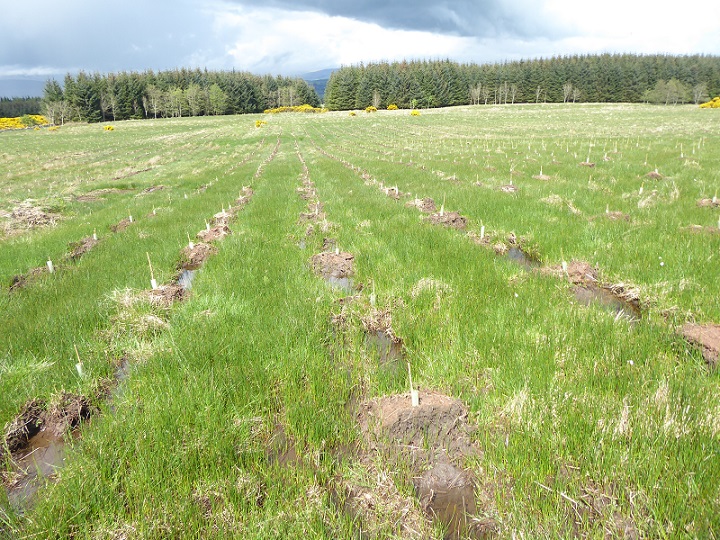 Marshy ground has its own value and, if this was too wet for trees to become established naturally, maybe it would have been better to leave it alone?
Marshy ground has its own value and, if this was too wet for trees to become established naturally, maybe it would have been better to leave it alone?
Below the existing plantations, which cut the site in two, the ground changed from unimproved grassland to more intensively used farmland. This had also been mounded but was still being grazed by sheep, presumably because there had not been time to plant trees this Spring:

The soils on this farmland will have been much more extensively modified than the semi-natural habitats above and been depleted of both carbon and nutrients. The trees that will be planted should therefore take less time to re-absorb the carbon released by the mounding and, if considered purely in carbon terms, planting on this farmland may make some sense. The planting of native woodland may also help replenish the soils, a better alternative to the ever increasing amounts of fertiliser required to keep much land productive.
There is another factor, however, to be considered and that concerns how woodland creation can displace animals and animal products. If government is really serious about addressing the climate emergency it needs to encourage the use of wool and other natural fibres to replace products derived from fossil fuels. Moreover, unless people reduce meat consumption, replacing sheep by trees on any site risks increasing grazing pressure somewhere else!
What are the lessons from Leckie for Far Ralia and woodland planting more generally?
I hope I have shown that there are serious questions to ask about the benefits of the native woodland creation scheme at Leckie, which has received public funding through Scottish Forestry. In particular I have highlighted the impact of planting on the landscape, carbon and sem-natural habitats.
The model used to establish native woodland at Leckie, intensive planting, mounding and use of plastic trees tubes is, as I will show in my next post, the same as Abrdn is proposing for Far Ralia. The result is little different from the conifer plantations from the 1980s and the explanation for this also the same: the more intense the planting, the more the financial gain for landowners (but this time carbon credits rather than tax relief). The fundamental issue here is that neither the Forestry Grants Scheme nor the Woodland Carbon Code are fit for purpose and both serve to encourage landowners to plant trees where none should be planted.
While outwith the National Park, it is worth considering the wider lessons from Leckie:

There is, as I explained above, a very strong case for planting trees on farmland with depleted soils However, while planting woodland in such places with the usual native trees which spread rapidly through natural regeneration (birch, rowan, Scots Pine) may have some benefits for carbon offsetting and nature, it would be much more sensible to use such land to grow timber for commercial purposes. That should include native hardwoods, such as oak, which if used in buildings would lock up carbon for far longer periods than shorter-lived species like rowan and birch.
I have not seen the forest plans for Leckie and maybe the intention is to plant native hardwoods and Scots Pine on the remaining lower ground – if so, that would make some sense.
What has happened on the upper slopes and the unimproved grassland is much harder to justify from an environmental perspective.

Besides the damage the planting to soils and existing habitats, most of the arguments against tree planting in National Parks apply here. There is a reasonably plentiful seed source, so many of the species that have been planted would regenerate naturally if grazing was reduced. Probably not on the wetter ground, where more marshy habitats would develop but that would be a good thing.
Meantime, the continuation of some grazing by cattle could create a native woodland far more natural in form, age and extent. This would be far better for wildlife than the new even-aged plantation whose only recreational value may well lie in pheasant shooting.
Such a vision, however, is almost impossible to achieve under our current system of landownership and the accompanying regulatory and grant support schemes. Most large landowners want to make some return from their land – Anders Povslen the owner of Wildland Ltd is the obvious exception – and compared to planting the potential financial rewards from re-wilding are very low.
While reforming land ownership and management is complex, it is within the Scottish Government’s power to change the forestry grant scheme and that would a relatively easy thing to do. Without the planting subsidy one could ask whether the planting scheme at Leckie, which is registered under the Woodland Carbon Code, would have ever got off the ground? It’s the same with Abrdn at Far Ralia, without c£2.5m on offer from Scottish Forestry, the cheapest thing for them to do would be to employ a stalker to keep deer numbers down and leave the rest to natural processes. That would have far better outcomes for both carbon offsetting and biodiversity.
Or, to summarize, “It’s a big club and you aren’t in it”.
Meaning what? Are you able to provide any analysis ?
Oh look yet more biased disinformation and quite frankly, drivel, coming out of parkswatch.
They are clearly not chartered foresters and it seems that suggestions to focus on the scientific facts of carbon sequestration have gone entirely unheard, how unsurprising and exhausting it must be for the poor people bearing the brunt of parkswatch Militancy.
Well done to Leckie Estate and don’t listen to biased nay-sayers like parkswatch, which is out of its depth when it comes to truth and objective reason regarding afforestation.
Kind regards
A laird
Perhaps if you provided some facts readers might give your opinion(s) some time.
Sorry, but your rant – yes rant – didn’t produce any facts to counter this well researched article. If you believe the article was biased – produce the facts. I saw no objective reasoning in what you said – just head in the sand stuff!
Let’s have reasoned debate on these important issues, and not this emotive ranting.
It would be interesting to know when the removal of the gorse bushes took place. If it happened in the bird breeding season, were surveys undertaken to record birds nest, as required by the Wildlife and Countryside Act, to avoid disturbing or damaging them?